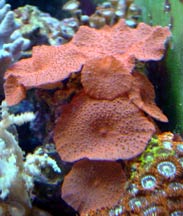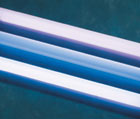Fluorescent Lighting Systems Because of their wide variety of sizes, wattages, and spectrum ranges, fluorescent systems are today's most popular type of lighting system. Fluorescent light bulbs are simply gas-filled glass tubes. When electricity is passed through the tube, the gasses within the tube heat to the point where they give off light. Fluorescent bulbs are coated inside with different blends of phosphors to achieve different spectrums of light. As the light passes through the coating, the phosphors produce colors based on their chemical makeup. However, regular use, along with the passage of time, degrades the gas and coating within the bulb, changing both the intensity and spectrum of the light produced by the bulb. Because of this, it is important that fluorescent bulbs are changed on a regular basis.
Because of their wide variety of sizes, wattages, and spectrum ranges, fluorescent systems are today's most popular type of lighting system. Fluorescent light bulbs are simply gas-filled glass tubes. When electricity is passed through the tube, the gasses within the tube heat to the point where they give off light. Fluorescent bulbs are coated inside with different blends of phosphors to achieve different spectrums of light. As the light passes through the coating, the phosphors produce colors based on their chemical makeup. However, regular use, along with the passage of time, degrades the gas and coating within the bulb, changing both the intensity and spectrum of the light produced by the bulb. Because of this, it is important that fluorescent bulbs are changed on a regular basis.
Common fluorescent systems include:
- Standard or Normal Output Fluorescent
- High Output (HO) and Very High Output (VHO)
- Compact Fluorescent
Standard Fluorescent Systems A standard fluorescent system includes a ballast designed for use with bulbs from 18" to 72" long. Standard fluorescent bulbs are offered in different diameters. The diameter is defined by the bulb's T-rating, which is based on a scale of 1/8" (a bulb with a T-rating of 8 has a 1" diameter). The most common diameters for standard fluorescent bulbs are T-8 and T-12. Most fixtures will accept either of the two. Two bulbs of the same length with different diameters will have different wattages - the bulb with the smaller diameter will have a lower wattage. For example, a 48" T-12 bulb produces 40 watts, whereas a 48" T-8 bulb produces only 32 watts. Standard fluorescent bulbs also offer a wide variety of spectrums, ranging from fish-only beauty lights to specialty plant bulbs and actinic bulbs for saltwater aquariums.
A standard fluorescent system includes a ballast designed for use with bulbs from 18" to 72" long. Standard fluorescent bulbs are offered in different diameters. The diameter is defined by the bulb's T-rating, which is based on a scale of 1/8" (a bulb with a T-rating of 8 has a 1" diameter). The most common diameters for standard fluorescent bulbs are T-8 and T-12. Most fixtures will accept either of the two. Two bulbs of the same length with different diameters will have different wattages - the bulb with the smaller diameter will have a lower wattage. For example, a 48" T-12 bulb produces 40 watts, whereas a 48" T-8 bulb produces only 32 watts. Standard fluorescent bulbs also offer a wide variety of spectrums, ranging from fish-only beauty lights to specialty plant bulbs and actinic bulbs for saltwater aquariums.
Standard fluorescent systems are a good choice for both freshwater and saltwater fish-only aquariums. Multiple-bulb systems can also be used for aquariums with live plants and corals that require only low levels of light.
T-5 HO And VHO Fluorescent Systems T-5 High Output (HO) and Very High Output (VHO) fluorescent systems are similar in design to standard fluorescent systems, but they offer higher light output. T-5 HO and VHO systems require different ballasts and end caps than those used with standard fluorescent systems. VHO and HO bulbs cannot be used with a standard fluorescent ballast.
T-5 High Output (HO) and Very High Output (VHO) fluorescent systems are similar in design to standard fluorescent systems, but they offer higher light output. T-5 HO and VHO systems require different ballasts and end caps than those used with standard fluorescent systems. VHO and HO bulbs cannot be used with a standard fluorescent ballast.
T-5 HO and VHO systems are typically used for saltwater reef aquariums. At one time, the spectrum available for these systems was typically in the higher Kelvin range. However, T-5 HO lamps are now available in a greater spectrum range, perfect for fresh and saltwater aquariums.
Compact Fluorescent Systems Compact fluorescent systems operate under the same principles as the other types of fluorescent systems. However, their appearance varies from standard, T-5 HO, and VHO systems. Instead of using one glass bulb, compact fluorescent systems incorporate bulbs with a twin-tube design. Wattage ratings on these bulbs include both tubes in the total output of the bulb.
Compact fluorescent systems operate under the same principles as the other types of fluorescent systems. However, their appearance varies from standard, T-5 HO, and VHO systems. Instead of using one glass bulb, compact fluorescent systems incorporate bulbs with a twin-tube design. Wattage ratings on these bulbs include both tubes in the total output of the bulb.
Compact fluorescent systems are commonly available in two designs: square-pin and straight-pin socket bases. Sockets have been designed for the pin layout of the specific bulb type (square-pin or straight-pin). Therefore, bulbs cannot be interchanged in the sockets.
Compact fluorescents are an excellent choice for any type of aquarium due to their low operating cost, bulb longevity, and wide variety of spectrums. Low Kelvin-rated power compact bulbs work well for freshwater planted aquariums, while higher blue spectrum bulbs are effective on saltwater reef aquariums.
Part two of this article will discuss metal halide and HQI aquarium lighting systems.





Leave a comment
This site is protected by hCaptcha and the hCaptcha Privacy Policy and Terms of Service apply.